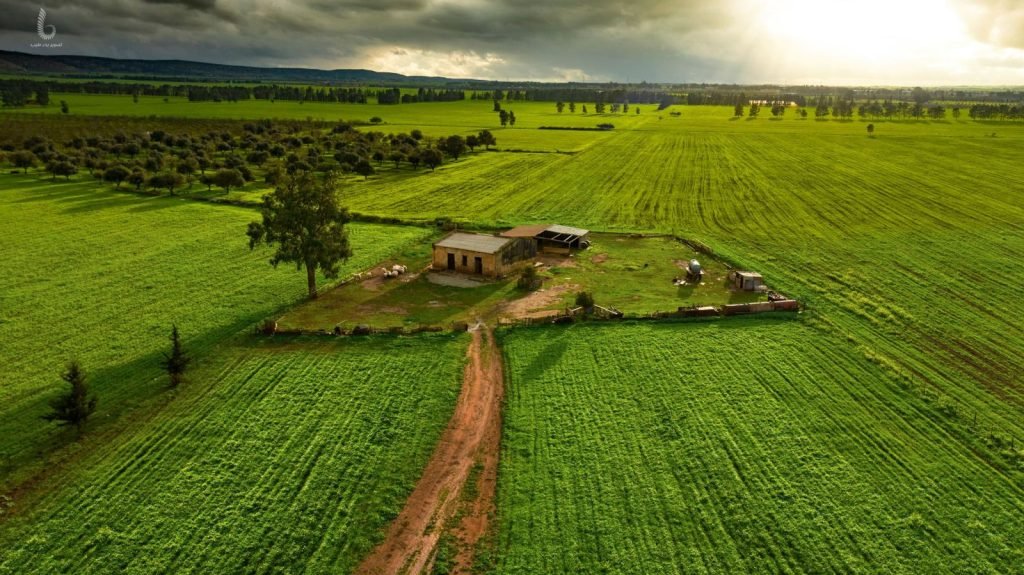We recognise the transformative potential of renewable energy in Libya. As a leading Libya-based service provider, Qabas is dedicated to harnessing sustainable resources to drive our nation’s energy future. Our expert team delivers innovative solutions that set industry benchmarks, ensuring reliable and efficient energy systems.
At Qabas, we’re committed to advancing Libya’s renewable energy landscape. By integrating cutting-edge technologies and strategic planning, we aim to contribute to a greener and more resilient economy. Our focus on excellence and expertise positions us at the forefront of the renewable energy sector in Libya.
Table of Contents

Current Energy Landscape In Libya
Dominance of Fossil Fuels
Libya’s energy sector relies predominantly on fossil fuels, with oil and natural gas serving as the primary sources. As of 2010, the nation’s total electricity installed capacity reached 6.8 GW, almost entirely generated by power plants fueled by oil or natural gas. This heavy dependence on hydrocarbons has sustained Libya’s economy and energy generation capabilities.
Electricity Demand and Supply
Electricity demand in Libya has surged alongside economic expansion and substantial investments in the oil and gas sectors. Despite these investments, the increase in electricity demand has frequently surpassed the growth in installed generation capacity, resulting in periodic electricity shortfalls prior to the 2011 civil war. Nevertheless, Libya boasts a remarkable 99.8% electricity access rate among its population, the highest in Africa.
As a Libya-based service provider, we at Qabas address these challenges by offering advanced energy solutions. Our services include the development and maintenance of power generation infrastructure, energy management systems, and sustainable resource integration. By leveraging our expertise and ethical standards, we contribute to stabilizing Libya’s energy supply and meeting the growing demand efficiently.

Renewable Energy Potential
Libya possesses substantial renewable energy resources, particularly in solar and wind power, owing to its advantageous geographical location. These resources offer significant opportunities to enhance the country’s energy landscape sustainably.
Solar Energy
Libya benefits from an average of 3,200 brightness hours annually and receives approximately 6 kWh per m² per day of solar radiation. This makes the nation an exceptional candidate for solar energy generation. Each square kilometre of Libyan desert can capture solar energy equivalent to 1.5 million barrels of crude oil each year. With the potential to generate up to 5.3 terawatt-hours (TWh) of solar energy annually, our current electricity consumption of around 3.5 TWh per year can be more than doubled. We leverage these advantages by deploying advanced solar technologies and efficient energy solutions to maximise this potential.
Wind Energy
Libya’s wind energy potential is equally impressive, with average wind speeds ranging from 6 to 7.7 metres per second at 40 metres above ground level. These consistent wind speeds are ideal for harnessing wind power effectively. By utilising our expertise in wind energy infrastructure and management, we aim to tap into this resource to contribute significantly to Libya’s renewable energy supply. Our dedicated approach ensures the reliable and efficient integration of wind energy into the national grid, supporting a sustainable and resilient energy future.
Government Policies And Initiatives
Libya has launched several government policies to advance renewable energy and enhance energy efficiency. The National Strategy for Renewable Energies and Energy Efficiency 2023-2035, introduced by Prime Minister Abdul Hamid Dbeibah in December 2023, serves as a cornerstone for these efforts. Developed by the Ministry of Planning in partnership with USAID, the strategy outlines a structured approach to energy transformation.
National Strategy for Renewable Energies and Energy Efficiency 2023-2035
The strategy focuses on four main axes to drive renewable energy growth and reduce energy consumption:
- Energy Diversification: Aims to increase renewable energy contributions to the national grid.
- Solar Energy Development: Targets the deployment of solar technologies.
- Wind Energy Expansion: Focuses on harnessing wind power potential.
- Energy Efficiency Improvement: Seeks to optimize energy use across sectors.
| Renewable Energy Source | Capacity Target by 2025 | Capacity Target by 2035 |
|---|---|---|
| Solar Photovoltaic (PV) | 1.7 GW | 3.3 GW |
| Wind Power | 600 MW | 600 MW |
| Concentrating Solar Power (CSP) | 100 MW | 100 MW |
| Total Renewable Energy Capacity | 2.4 GW | 4,000 MW |
Libya aims to achieve a total renewable energy capacity of 4,000 megawatts by 2035. Specifically, the deployment includes 1.7 GW of solar photovoltaic (PV) capacity by 2025, increasing to 3.3 GW by 2035. Wind power is set to contribute 600 MW, while concentrating solar power (CSP) will add 100 MW to the energy mix.
As a Libya-based service provider, we at Qabas align our expertise with these national objectives. Our commitment to ethical practices ensures that we support the strategic deployment of renewable technologies, contributing to Libya’s sustainable energy future.
Challenges And Opportunities
Challenges
Dependence on Fossil Fuels
Libya heavily relies on oil and gas for both energy and revenue, making the transition to renewable sources complex. This dependence restricts the diversification of the energy portfolio despite the country’s substantial renewable resources. Our expertise in renewable energy solutions facilitates the gradual reduction of fossil fuel reliance by integrating sustainable alternatives into Libya’s energy mix.
Regulatory Framework
The absence of a clear and supportive regulatory framework poses a significant barrier to renewable energy development. Libya requires the enactment of an Electricity Law that incentivises renewable investments and restructures energy tariffs to enhance competitiveness. Additionally, reallocating subsidies from fossil fuels to renewable energy and establishing a regulatory body to monitor compliance are essential steps. We support these initiatives by providing consultancy and strategic planning to navigate and influence the evolving regulatory landscape.
Opportunities
Abundant Renewable Resources
Libya boasts significant solar and wind energy potential, presenting a substantial opportunity for sustainable energy generation. With an average of 3,200 brightness hours annually and approximately 6 kWh per m² per day of solar radiation, the country can generate up to 5.3 terawatt-hours (TWh) of solar energy each year. Additionally, average wind speeds ranging from 6 to 7.7 metres per second are ideal for wind power development. We leverage these natural advantages by deploying advanced solar photovoltaic systems and efficient wind turbines, harnessing Libya’s renewable resources to their full potential.
Government Initiatives
The National Strategy for Renewable Energies and Energy Efficiency 2023-2035 underscores Libya’s commitment to energy diversification, solar and wind energy expansion, and enhanced energy efficiency. The strategy targets a total renewable energy capacity of 4,000 megawatts by 2035, including 1.7 gigawatts (GW) of solar photovoltaic capacity by 2025 and 600 megawatts (MW) from wind power. Our alignment with these national objectives ensures that we contribute effectively to Libya’s sustainable energy future through the implementation of advanced technologies and strategic energy solutions.

Future Prospects
Libya’s renewable energy targets provide a robust framework for advancing our sustainable energy landscape. By 2025, we aim to generate 10% of Libya’s power from renewable sources, increasing to 30% by 2030 as outlined in the Strategic Plan for Renewable Energy 2013–2025. Building on the National Strategy for Renewable Energy and Energy Efficiency initiated in December 2023, our focus extends to achieving 4 GW of combined solar and wind capacity by 2035, contributing to a 20% renewable energy share in the national power mix.
Solar Energy Advancements
Libya’s solar potential is exceptional, boasting approximately 3,200 annual brightness hours and an average solar radiation of 6 kWh per m² per day. Each square kilometre of desert land receives solar energy equivalent to 1.5 million barrels of crude oil annually. We leverage this immense potential by deploying advanced solar panel installations and efficient energy management systems. Our initiatives are designed to harness and integrate solar energy seamlessly into Libya’s energy infrastructure, ensuring reliable and sustainable power generation.
Wind Energy Developments
The country’s wind energy resources are equally promising, with average wind speeds ranging from 6 to 7.7 metres per second. This consistent wind flow facilitates the efficient generation of wind power, which complements our solar projects. We invest in state-of-the-art wind turbine technologies and infrastructure to maximize energy output and ensure the stability of the renewable energy supply. Our efforts are directed towards integrating wind energy solutions into the national grid, enhancing overall energy resilience.
Strategic Implementations
To achieve these ambitious targets, we offer a range of specialised services, including project development, system design, installation, and maintenance of renewable energy systems. Our expertise in energy efficiency supports the optimisation of energy use across various sectors, aligning with Libya’s goals for a greener economy. By adhering to ethical practices and maintaining a non-corrupt stance, we ensure the integrity and success of our renewable energy projects.
Our trusted reputation in the industry underscores our commitment to driving Libya’s renewable energy agenda forward. Through meticulous planning and the implementation of advanced technologies, we contribute to reducing the nation’s dependence on fossil fuels. Our strategic initiatives not only support current energy needs but also pave the way for a resilient and sustainable energy future for Libya.
Renewable Energy in Libya: Conclusion
Embracing renewable energy is a pivotal step for Libya’s sustainable future. We are committed to driving the transition by harnessing the country’s vast solar and wind resources. Our efforts aim to support economic resilience and environmental stewardship. Together, we can build a greener and more prosperous Libya by advancing innovative energy solutions and fostering strategic partnerships. Moving forward our dedication to renewable energy underscores our vision for a sustainable and energy-secure nation.
Frequently Asked Questions
What is the role of renewable energy in Libya’s future?
Renewable energy plays a crucial role in Libya’s future by diversifying the energy mix, reducing dependence on fossil fuels, and fostering a sustainable economy. With abundant solar and wind resources, Libya aims to increase renewable energy capacity to 4,000 megawatts by 2035. This transition supports environmental goals, enhances energy security, and creates opportunities for economic growth through innovative energy solutions and advanced technologies.
Who is Qabas and what is their role in Libya’s renewable energy sector?
Qabas is a leading company in Libya‘s renewable energy sector, committed to utilising sustainable resources to enhance the nation’s energy landscape. The company focuses on developing and maintaining power generation infrastructure, implementing energy management systems, and deploying advanced solar and wind technologies. Qabas aligns its efforts with Libya’s national renewable energy strategy, contributing to a greener and more resilient economy by providing innovative and efficient energy solutions.
What are Libya’s main renewable energy sources?
Libya’s primary renewable energy sources are solar and wind power. The country benefits from an average of 3,200 brightness hours annually and approximately 6 kWh per m² per day of solar radiation, enabling the production of up to 5.3 terawatt-hours of solar energy each year. Additionally, Libya’s wind energy potential is significant, with average wind speeds ranging from 6 to 7.7 metres per second, making it ideal for wind power generation and integration into the national grid.
How does Qabas contribute to Libya’s energy stability?
Qabas enhances Libya’s energy stability by providing advanced energy solutions, including the development and maintenance of power generation infrastructure and energy management systems. By integrating solar and wind energy into the national grid, Qabas ensures a reliable and consistent energy supply. Their expertise in deploying efficient technologies and strategic planning helps mitigate electricity shortfalls and supports the overall stability of Libya’s energy landscape.
What government initiatives support renewable energy in Libya?
The National Strategy for Renewable Energies and Energy Efficiency 2023-2035, introduced by Prime Minister Abdul Hamid Dbeibah, is a key government initiative supporting renewable energy in Libya. This strategy focuses on diversifying energy sources, developing solar and wind energy, and improving energy efficiency. It aims to achieve a total renewable energy capacity of 4,000 megawatts by 2035. These initiatives provide a framework for companies like Qabas to align their projects with national objectives and promote sustainable energy development.
What challenges does Libya face in transitioning to renewable energy?
Libya faces several challenges in transitioning to renewable energy, including a heavy dependence on fossil fuels and a lack of a supportive regulatory framework. The existing energy infrastructure is primarily oil and natural gas-based, which complicates diversification efforts. Additionally, the absence of an Electricity Law hinders renewable investments and the restructuring of energy tariffs. Overcoming these barriers requires strategic planning, regulatory support, and continued investment in renewable technologies.
What is Libya’s national strategy for renewable energies?
Libya’s National Strategy for Renewable Energies and Energy Efficiency 2023-2035 focuses on energy diversification, the development of solar and wind power, and the improvement of energy efficiency. The strategy sets a target of achieving 4,000 megawatts of renewable energy capacity by 2035 and aims to generate 10% of power from renewables by 2025, increasing to 30% by 2030. This comprehensive plan provides a roadmap for sustainable energy development, supporting economic growth and environmental sustainability.
How does Qabas align with Libya’s renewable energy goals?
Qabas aligns with Libya’s renewable energy goals by synchronising its projects with the national strategy for energy diversification and sustainability. The company focuses on deploying solar and wind technologies that contribute to the target of 4,000 megawatts of renewable capacity by 2035. By implementing advanced energy solutions and adhering to ethical practices, Qabas supports the strategic objectives of increasing renewable energy share, enhancing energy efficiency, and fostering a resilient and sustainable energy future for Libya.




